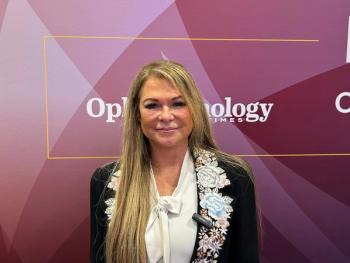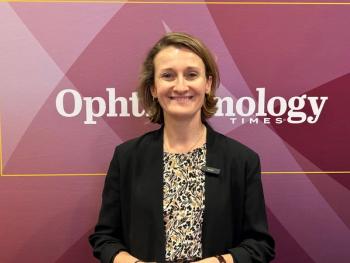
Imaging the choroid: The new frontier
By Liz Meszaros
Reviewed by Srinivas Sadda, MD
Los Angeles-Advances in optical coherence tomography (OCT) imaging and analysis have allowed the choroid to become accessible.
“The choroid shows significant inter-individual, regional, and temporal variations that must be considered when interpreting choroidal thickness findings,” said Srinivas Sadda, MD, associate professor of ophthalmology, University of Southern California Keck School of Medicine, Los Angeles. “Choroidal vascular imaging with OCT is now possible, and the role of the choroid in the pathogenesis of various diseases will be a topic of great interest in the future.”
Techniques to access the choroid include optimization of choroidal position relative to zero eelay, which is “generally set to the vitreous side by default in most devices,” Dr. Sadda noted. “Loss of sensitivity with increasing distance from the zero delay line is inherent to spectral-domain OCT [SD-OCT].”
The slope of sensitivity roll-off may vary from instrument to instrument as well, he noted.
Other techniques for accessing the choroid include B-scan frame averaging; longer wavelength; and the method of Fourier detection (SD-OCT), such as the use of swept-source OCT that features higher speed and less sensitivity roll-off, as well as a longer wavelength.
“What is most important depends on the instrument you are using,” said Dr. Sadda, who is also director of the Doheny Image Reading Center, Doheny Eye Institute, Los Angeles.
Importance of choroidal imaging
Choroidal thickness varies in different diseases. For example, the average foveal center point thickness in normal subjects is 280 to 290 μm; in patients with central serous chorioretinopathy (CSCR), it is 400 to 500 μm; in patients with high myopia, about 90 μm; and in patients with age-related macular degeneration (AMD) and age-related choroidal atrophy (ARCA), 120 μm.
Both inter-individual and spatial variations exist in the choroidal thicknesses of normal, and it critical to understand that in order to interpret choroidal changes in disease.1 Ouyang et al. conducted a study in 59 eyes from 30 normal subjects, and prospectively examined them with both OCT (Cirrus, Carl Zeiss Meditec) and a prototype SD-OCT (Carl Zeiss Meditec) operating at 1,050 nm. Macular cube volume scans (512 â 128) centered on the fovea were obtained in all subjects. A series of volume scans were conducted in a subset of individuals. These were centered at multiple locations throughout the posterior pole in order to construct broad-field thickness maps spanning regions superior, inferior, temporal, and nasal to the optic nerve.
The raw OCT data were analyzed with DIRC OCT grading software (3D-OCTOR), which allowed the grader to draw the inner and outer boundaries of the choroid manually on multiple B-scans for computation of choroidal thickness.
Choroidal thickness measurements showed considerable inter-individual variations, and were thickest in the foveal central subfield (mean: 289 μm) and superior to the foveal center (301 μm), and thinnest in the nasal field (247 μm).
No statistically significant correlation was found between the average choroidal thickness in any subfield and age, axial length, or refractive error. Dr. Sadda acknowledged that this was a small series, and the choroid was generally thinner in myopic eyes, regardless of location.
Choroidal thickness maps were then generated from locations beyond the central grid to construct large field/montage thickness maps. From these, the following consistent patterns were observed:
Choroidal thickness increased as one moved superiorly, nasally or temporally from the optic nerve, to a maximum level at a certain distance from the nerve, but decreased as one moved inferiorly.
“This probably reflects closure of the embryonic choroidal fissure. We all have relative coloboma!” Dr. Sadda commented.
“Given the significant inter-individual variation in choroidal thickness, various points in the fundus were considered as reference points from which to model choroidal thickness,” he said. “The center of the optic nerve yielded the most consistent relationship among patients.”
Further, there was no statistically significant correlation between the average choroidal thickness in any subfield and age, axial length, or refractive error.
Ouyang and Walsh2 showed that choroidal thickness varies considerably between individuals and by spatial location, that the optic nerve center rather than the foveal center may be the preferred reference point for modeling choroidal thickness, and that the choroidal thickness appears to increase superior, nasal, and temporal to the optic nerve, but less so inferiorly. They concluded that regional variations in choroidal thickness must be considered when assessing the significance of choroidal findings in retinal disease.
Tan et al. found that there are also circadian variations in choroidal thickness.3 They included 12 healthy adults with confirmed absence of ocular disease in both eyes for their prospective study, and using enhanced depth imaging scans performed in both eyes at five time points (2 hours apart), and repeat scans performed several days later, they found that choroidal thickness showed an apparent, predictable, and characteristic diurnal variation in normal eyes.
The choroidal circadian rhythm was characterized by a thinning during the day, and a thickening overnight in a confirmatory study by Usui and colleagues.4
Furthermore, Tan et al. found that absolute choroidal thickness was an important predictor of the magnitude of the variation from day to night, with thicker choroids showing more variation. Hyperopia and shorter axial length were associated with greater amplitudes of variation as well as greater choroidal thickness.
Finally, they found that greater changes in systolic blood pressures were associated with greater changes in thickness, Dr. Sadda said.
Putting choroidal imaging to use
The clinical applications of imaging include age-related maculopathy, pathologic myopia, CSCR, neovascular AMD (choroidal neovascularization [CNV]), and tumors, Dr. Sadda said.
“Spaide and others have also demonstrated that the choroid is much thinner in eyes with AMD and in patients with ARCA,” he said. “ARCA is a common problem, especially in older patients with non-specific complaints, such as trouble reading and trouble with adaptation to changes in lighting. In addition, the typical features of AMD, such as large drusen, are absent in these patients.”
He presented a hypothesis for future study that holds that if the choroid is thin in AMD, CNV (i.e., augmenting the choroid) could be a compensatory response.
“The question remains, should we be more cautious with aggressive therapy in such individuals,” Dr. Sadda said.OT
References
1. Margolis R, Spaide RF. A pilot study of enhanced depth imaging optical coherence tomography of the choroid in normal eyes. Am J Ophthalmol. 2009;147:811-815. doi: 10.1016/j.ajo.2008.12.008. Epub 2009 Feb 20.
2.
3. Tan GS, Ouyang Y, Ruiz H. Sadda SR. Diurnal variation of choroidal thickness in normal, healthy subjects measured by spectral domain optical coherence tomography. Invest Ophthalmol Vis Sci. 2012;53:261-266.
4. Usui S, Ikuno Y, Akiba M, Maruko I, Sekiryu T, Nishida K, Iida T. Circadian changes in subfoveal choroidal thickness and the relationship with circulatory factors in healthy subjects. Invest Ophthalmol Vis Sci. 2012;53:2300-2307. doi: 10.1167/iovs.11-8383.
FYI
Srinivas Sadda, MD
Phone: 323/442-6522
This article was adapted from Dr. Sadda’s presentation at the 25th annual Current Concepts in Ophthalmology meeting in Baltimore in association with the Wilmer Eye Institute and Ophthalmology Times. Dr. Sadda presented the Joseph A. Smiddy Memorial lecture.
Newsletter
Don’t miss out—get Ophthalmology Times updates on the latest clinical advancements and expert interviews, straight to your inbox.



















































.png)


